Systematic Review on Yoga's Effectiveness for Hypertensive Adults
VerifiedAdded on 2020/04/07
|18
|5826
|238
Report
AI Summary
This report presents a systematic review evaluating the impact of yoga on reducing blood pressure in hypertensive adults. The study examines various yoga practices like Shavasana and Iyengar yoga and their effects on blood pressure control. It explores the potential of yoga as a non-pharmacological intervention for managing hypertension, pre-hypertension, and related cardiovascular risks. The review analyzes existing literature, including clinical trials and meta-analyses, to assess the effectiveness of yoga in lowering both systolic and diastolic blood pressure. The findings suggest that consistent yoga practice, over periods ranging from 11-12 weeks, can lead to significant reductions in blood pressure and potentially reduce or eliminate the need for medication in some patients. However, the review also acknowledges the need for caution, as some initial yoga postures can temporarily increase blood pressure. The report highlights the significance of yoga in holistic health development and provides recommendations for future research and practice.
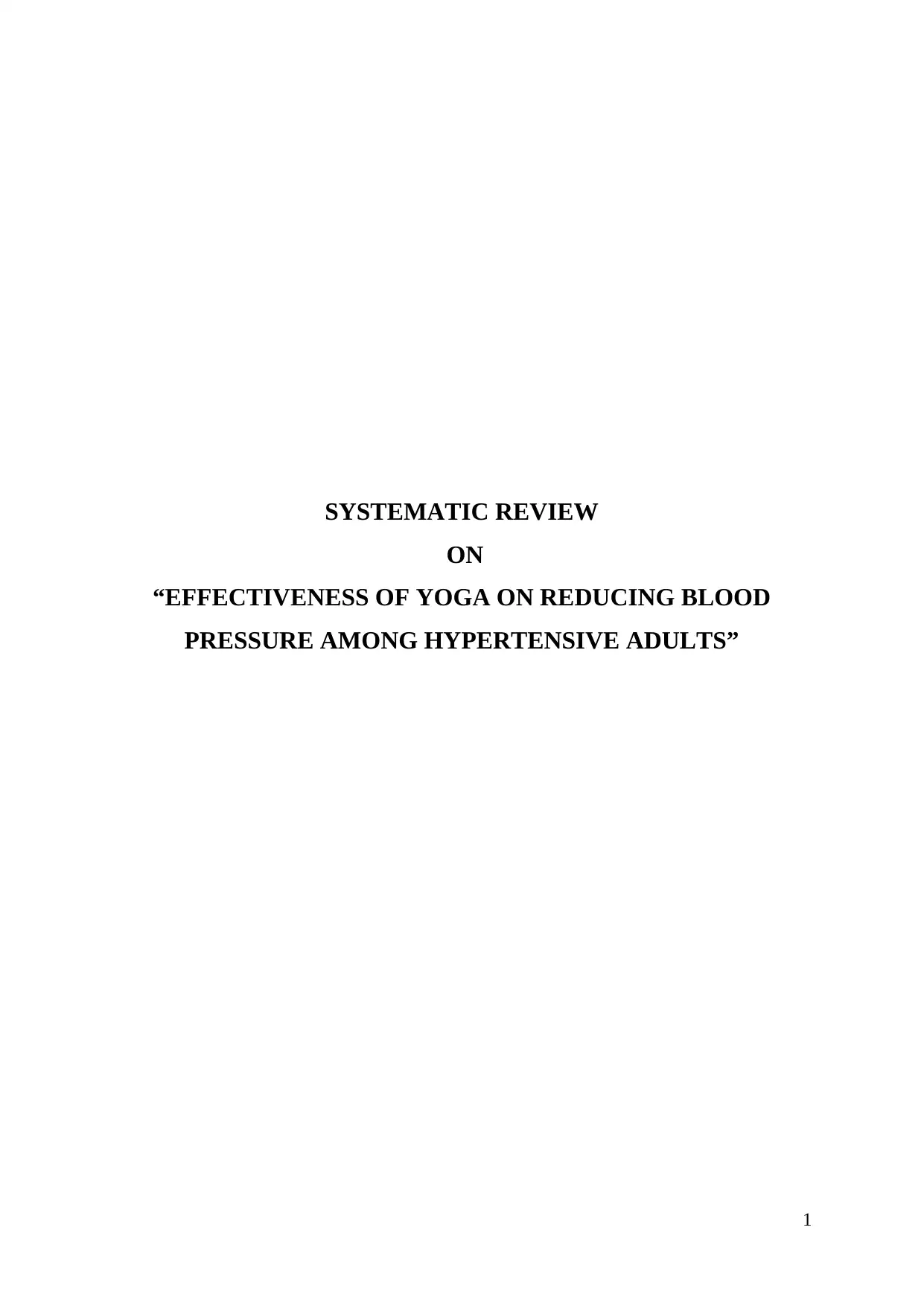
SYSTEMATIC REVIEW
ON
“EFFECTIVENESS OF YOGA ON REDUCING BLOOD
PRESSURE AMONG HYPERTENSIVE ADULTS”
1
ON
“EFFECTIVENESS OF YOGA ON REDUCING BLOOD
PRESSURE AMONG HYPERTENSIVE ADULTS”
1
Paraphrase This Document
Need a fresh take? Get an instant paraphrase of this document with our AI Paraphraser
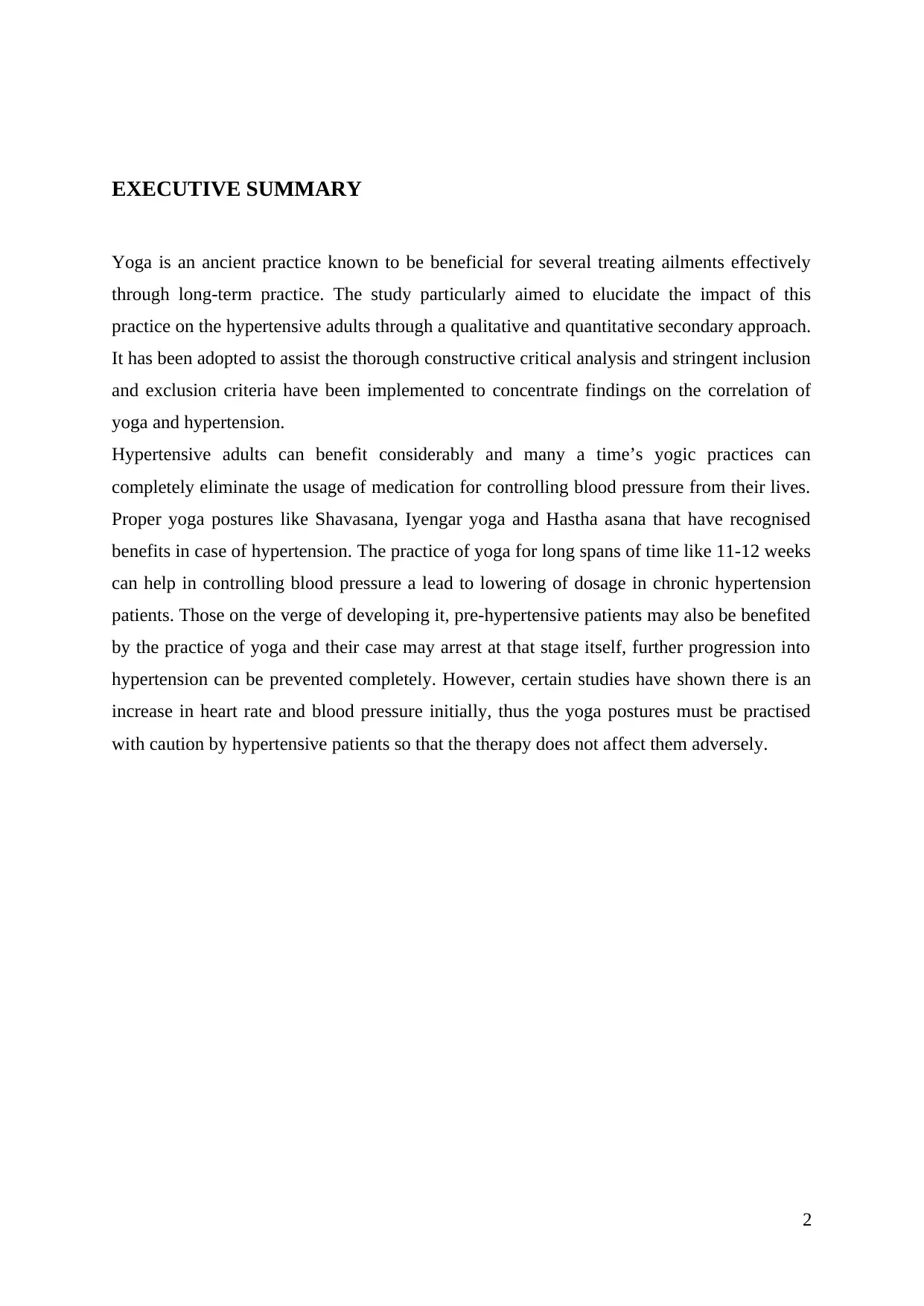
EXECUTIVE SUMMARY
Yoga is an ancient practice known to be beneficial for several treating ailments effectively
through long-term practice. The study particularly aimed to elucidate the impact of this
practice on the hypertensive adults through a qualitative and quantitative secondary approach.
It has been adopted to assist the thorough constructive critical analysis and stringent inclusion
and exclusion criteria have been implemented to concentrate findings on the correlation of
yoga and hypertension.
Hypertensive adults can benefit considerably and many a time’s yogic practices can
completely eliminate the usage of medication for controlling blood pressure from their lives.
Proper yoga postures like Shavasana, Iyengar yoga and Hastha asana that have recognised
benefits in case of hypertension. The practice of yoga for long spans of time like 11-12 weeks
can help in controlling blood pressure a lead to lowering of dosage in chronic hypertension
patients. Those on the verge of developing it, pre-hypertensive patients may also be benefited
by the practice of yoga and their case may arrest at that stage itself, further progression into
hypertension can be prevented completely. However, certain studies have shown there is an
increase in heart rate and blood pressure initially, thus the yoga postures must be practised
with caution by hypertensive patients so that the therapy does not affect them adversely.
2
Yoga is an ancient practice known to be beneficial for several treating ailments effectively
through long-term practice. The study particularly aimed to elucidate the impact of this
practice on the hypertensive adults through a qualitative and quantitative secondary approach.
It has been adopted to assist the thorough constructive critical analysis and stringent inclusion
and exclusion criteria have been implemented to concentrate findings on the correlation of
yoga and hypertension.
Hypertensive adults can benefit considerably and many a time’s yogic practices can
completely eliminate the usage of medication for controlling blood pressure from their lives.
Proper yoga postures like Shavasana, Iyengar yoga and Hastha asana that have recognised
benefits in case of hypertension. The practice of yoga for long spans of time like 11-12 weeks
can help in controlling blood pressure a lead to lowering of dosage in chronic hypertension
patients. Those on the verge of developing it, pre-hypertensive patients may also be benefited
by the practice of yoga and their case may arrest at that stage itself, further progression into
hypertension can be prevented completely. However, certain studies have shown there is an
increase in heart rate and blood pressure initially, thus the yoga postures must be practised
with caution by hypertensive patients so that the therapy does not affect them adversely.
2
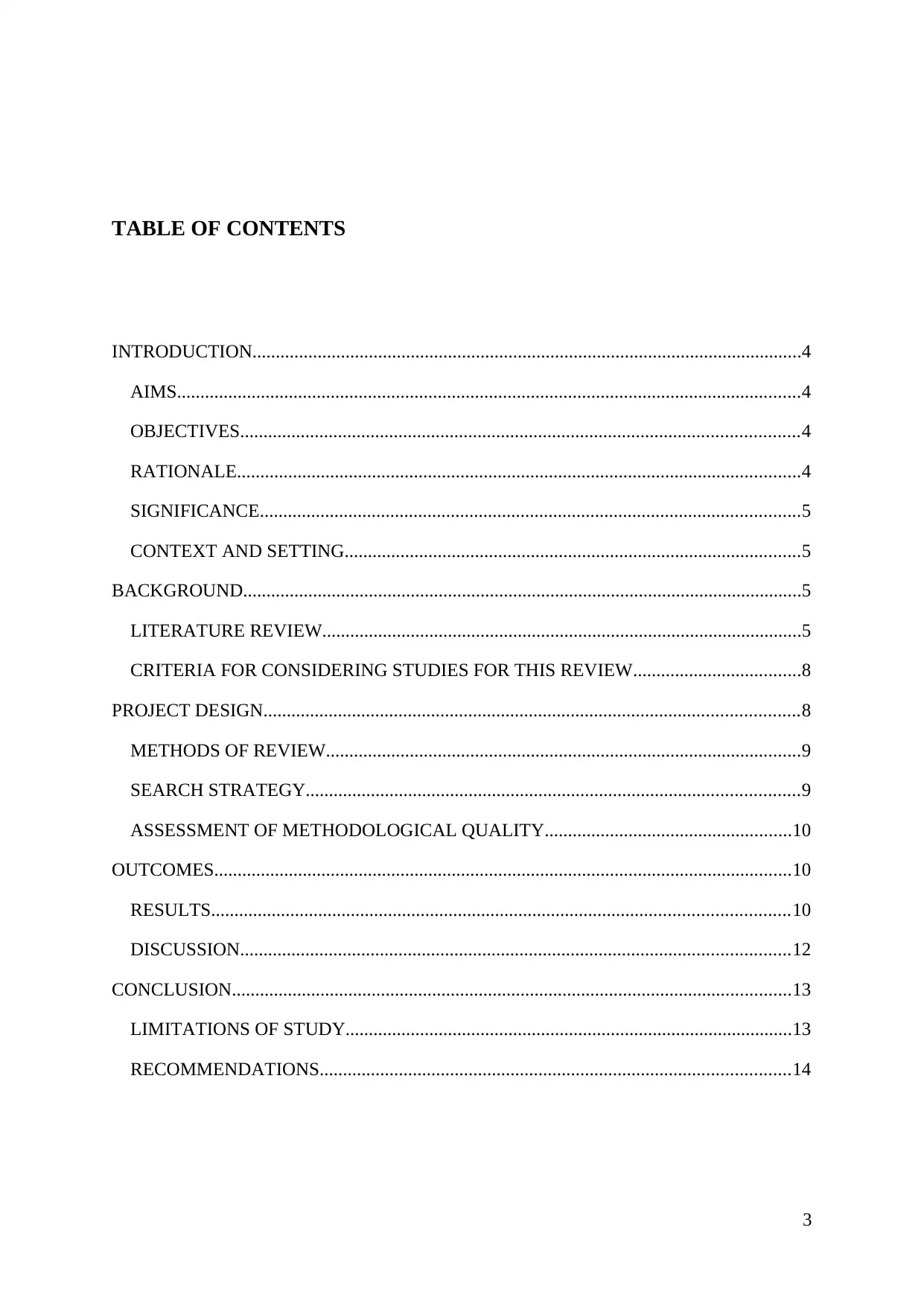
TABLE OF CONTENTS
INTRODUCTION......................................................................................................................4
AIMS......................................................................................................................................4
OBJECTIVES........................................................................................................................4
RATIONALE.........................................................................................................................4
SIGNIFICANCE....................................................................................................................5
CONTEXT AND SETTING..................................................................................................5
BACKGROUND........................................................................................................................5
LITERATURE REVIEW.......................................................................................................5
CRITERIA FOR CONSIDERING STUDIES FOR THIS REVIEW....................................8
PROJECT DESIGN...................................................................................................................8
METHODS OF REVIEW......................................................................................................9
SEARCH STRATEGY..........................................................................................................9
ASSESSMENT OF METHODOLOGICAL QUALITY.....................................................10
OUTCOMES............................................................................................................................10
RESULTS............................................................................................................................10
DISCUSSION......................................................................................................................12
CONCLUSION........................................................................................................................13
LIMITATIONS OF STUDY................................................................................................13
RECOMMENDATIONS.....................................................................................................14
3
INTRODUCTION......................................................................................................................4
AIMS......................................................................................................................................4
OBJECTIVES........................................................................................................................4
RATIONALE.........................................................................................................................4
SIGNIFICANCE....................................................................................................................5
CONTEXT AND SETTING..................................................................................................5
BACKGROUND........................................................................................................................5
LITERATURE REVIEW.......................................................................................................5
CRITERIA FOR CONSIDERING STUDIES FOR THIS REVIEW....................................8
PROJECT DESIGN...................................................................................................................8
METHODS OF REVIEW......................................................................................................9
SEARCH STRATEGY..........................................................................................................9
ASSESSMENT OF METHODOLOGICAL QUALITY.....................................................10
OUTCOMES............................................................................................................................10
RESULTS............................................................................................................................10
DISCUSSION......................................................................................................................12
CONCLUSION........................................................................................................................13
LIMITATIONS OF STUDY................................................................................................13
RECOMMENDATIONS.....................................................................................................14
3
⊘ This is a preview!⊘
Do you want full access?
Subscribe today to unlock all pages.

Trusted by 1+ million students worldwide

4
Paraphrase This Document
Need a fresh take? Get an instant paraphrase of this document with our AI Paraphraser
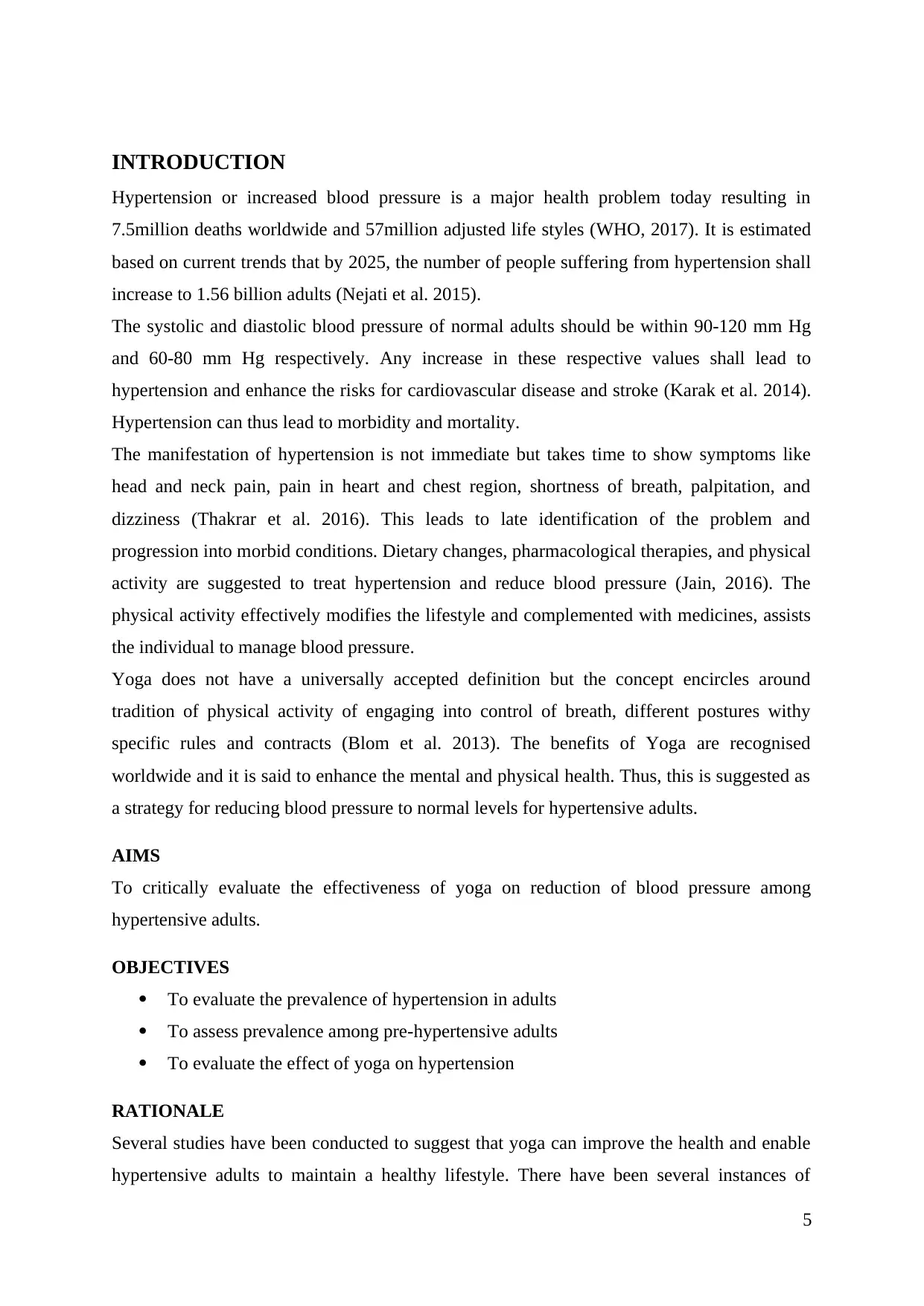
INTRODUCTION
Hypertension or increased blood pressure is a major health problem today resulting in
7.5million deaths worldwide and 57million adjusted life styles (WHO, 2017). It is estimated
based on current trends that by 2025, the number of people suffering from hypertension shall
increase to 1.56 billion adults (Nejati et al. 2015).
The systolic and diastolic blood pressure of normal adults should be within 90-120 mm Hg
and 60-80 mm Hg respectively. Any increase in these respective values shall lead to
hypertension and enhance the risks for cardiovascular disease and stroke (Karak et al. 2014).
Hypertension can thus lead to morbidity and mortality.
The manifestation of hypertension is not immediate but takes time to show symptoms like
head and neck pain, pain in heart and chest region, shortness of breath, palpitation, and
dizziness (Thakrar et al. 2016). This leads to late identification of the problem and
progression into morbid conditions. Dietary changes, pharmacological therapies, and physical
activity are suggested to treat hypertension and reduce blood pressure (Jain, 2016). The
physical activity effectively modifies the lifestyle and complemented with medicines, assists
the individual to manage blood pressure.
Yoga does not have a universally accepted definition but the concept encircles around
tradition of physical activity of engaging into control of breath, different postures withy
specific rules and contracts (Blom et al. 2013). The benefits of Yoga are recognised
worldwide and it is said to enhance the mental and physical health. Thus, this is suggested as
a strategy for reducing blood pressure to normal levels for hypertensive adults.
AIMS
To critically evaluate the effectiveness of yoga on reduction of blood pressure among
hypertensive adults.
OBJECTIVES
To evaluate the prevalence of hypertension in adults
To assess prevalence among pre-hypertensive adults
To evaluate the effect of yoga on hypertension
RATIONALE
Several studies have been conducted to suggest that yoga can improve the health and enable
hypertensive adults to maintain a healthy lifestyle. There have been several instances of
5
Hypertension or increased blood pressure is a major health problem today resulting in
7.5million deaths worldwide and 57million adjusted life styles (WHO, 2017). It is estimated
based on current trends that by 2025, the number of people suffering from hypertension shall
increase to 1.56 billion adults (Nejati et al. 2015).
The systolic and diastolic blood pressure of normal adults should be within 90-120 mm Hg
and 60-80 mm Hg respectively. Any increase in these respective values shall lead to
hypertension and enhance the risks for cardiovascular disease and stroke (Karak et al. 2014).
Hypertension can thus lead to morbidity and mortality.
The manifestation of hypertension is not immediate but takes time to show symptoms like
head and neck pain, pain in heart and chest region, shortness of breath, palpitation, and
dizziness (Thakrar et al. 2016). This leads to late identification of the problem and
progression into morbid conditions. Dietary changes, pharmacological therapies, and physical
activity are suggested to treat hypertension and reduce blood pressure (Jain, 2016). The
physical activity effectively modifies the lifestyle and complemented with medicines, assists
the individual to manage blood pressure.
Yoga does not have a universally accepted definition but the concept encircles around
tradition of physical activity of engaging into control of breath, different postures withy
specific rules and contracts (Blom et al. 2013). The benefits of Yoga are recognised
worldwide and it is said to enhance the mental and physical health. Thus, this is suggested as
a strategy for reducing blood pressure to normal levels for hypertensive adults.
AIMS
To critically evaluate the effectiveness of yoga on reduction of blood pressure among
hypertensive adults.
OBJECTIVES
To evaluate the prevalence of hypertension in adults
To assess prevalence among pre-hypertensive adults
To evaluate the effect of yoga on hypertension
RATIONALE
Several studies have been conducted to suggest that yoga can improve the health and enable
hypertensive adults to maintain a healthy lifestyle. There have been several instances of
5
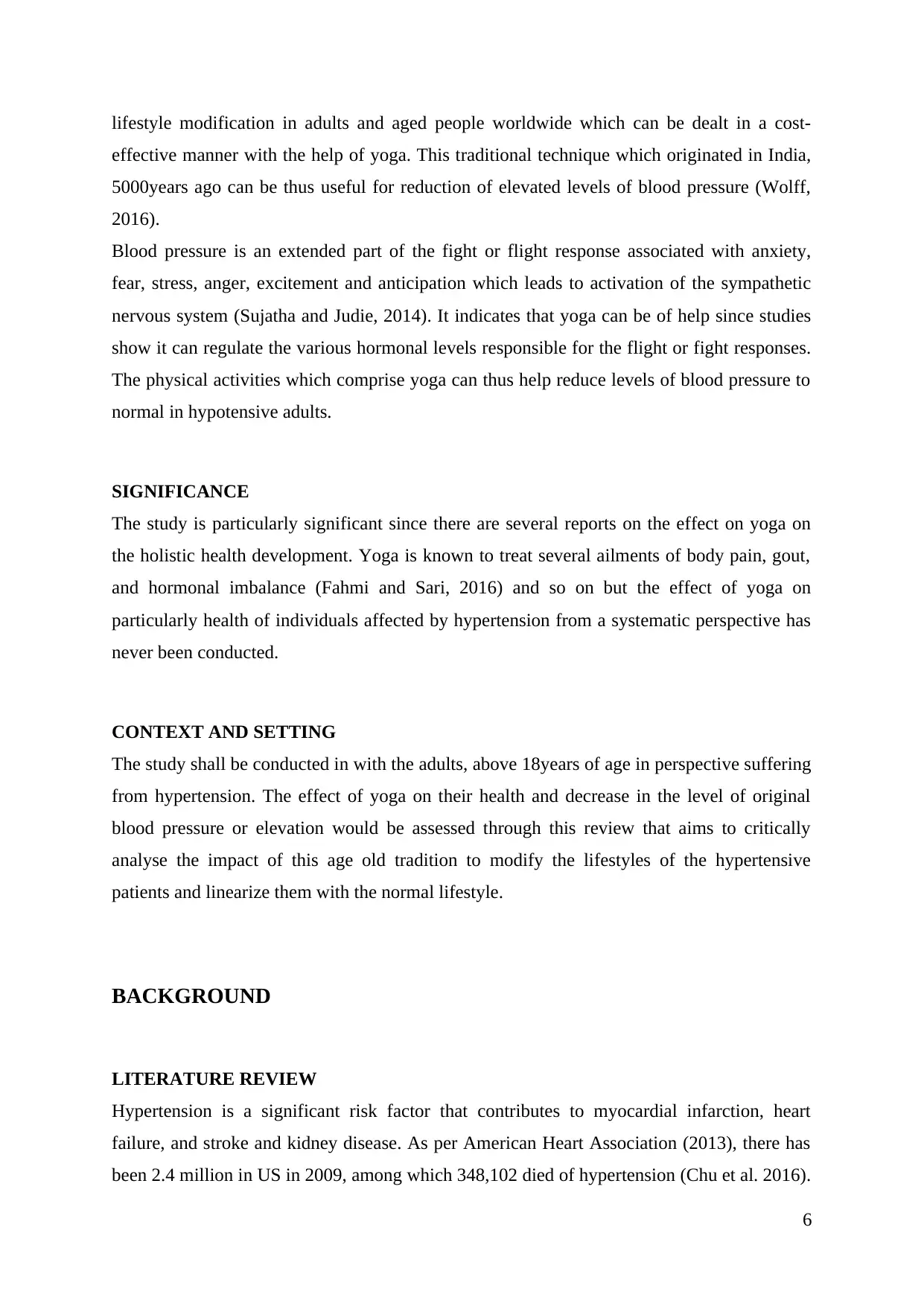
lifestyle modification in adults and aged people worldwide which can be dealt in a cost-
effective manner with the help of yoga. This traditional technique which originated in India,
5000years ago can be thus useful for reduction of elevated levels of blood pressure (Wolff,
2016).
Blood pressure is an extended part of the fight or flight response associated with anxiety,
fear, stress, anger, excitement and anticipation which leads to activation of the sympathetic
nervous system (Sujatha and Judie, 2014). It indicates that yoga can be of help since studies
show it can regulate the various hormonal levels responsible for the flight or fight responses.
The physical activities which comprise yoga can thus help reduce levels of blood pressure to
normal in hypotensive adults.
SIGNIFICANCE
The study is particularly significant since there are several reports on the effect on yoga on
the holistic health development. Yoga is known to treat several ailments of body pain, gout,
and hormonal imbalance (Fahmi and Sari, 2016) and so on but the effect of yoga on
particularly health of individuals affected by hypertension from a systematic perspective has
never been conducted.
CONTEXT AND SETTING
The study shall be conducted in with the adults, above 18years of age in perspective suffering
from hypertension. The effect of yoga on their health and decrease in the level of original
blood pressure or elevation would be assessed through this review that aims to critically
analyse the impact of this age old tradition to modify the lifestyles of the hypertensive
patients and linearize them with the normal lifestyle.
BACKGROUND
LITERATURE REVIEW
Hypertension is a significant risk factor that contributes to myocardial infarction, heart
failure, and stroke and kidney disease. As per American Heart Association (2013), there has
been 2.4 million in US in 2009, among which 348,102 died of hypertension (Chu et al. 2016).
6
effective manner with the help of yoga. This traditional technique which originated in India,
5000years ago can be thus useful for reduction of elevated levels of blood pressure (Wolff,
2016).
Blood pressure is an extended part of the fight or flight response associated with anxiety,
fear, stress, anger, excitement and anticipation which leads to activation of the sympathetic
nervous system (Sujatha and Judie, 2014). It indicates that yoga can be of help since studies
show it can regulate the various hormonal levels responsible for the flight or fight responses.
The physical activities which comprise yoga can thus help reduce levels of blood pressure to
normal in hypotensive adults.
SIGNIFICANCE
The study is particularly significant since there are several reports on the effect on yoga on
the holistic health development. Yoga is known to treat several ailments of body pain, gout,
and hormonal imbalance (Fahmi and Sari, 2016) and so on but the effect of yoga on
particularly health of individuals affected by hypertension from a systematic perspective has
never been conducted.
CONTEXT AND SETTING
The study shall be conducted in with the adults, above 18years of age in perspective suffering
from hypertension. The effect of yoga on their health and decrease in the level of original
blood pressure or elevation would be assessed through this review that aims to critically
analyse the impact of this age old tradition to modify the lifestyles of the hypertensive
patients and linearize them with the normal lifestyle.
BACKGROUND
LITERATURE REVIEW
Hypertension is a significant risk factor that contributes to myocardial infarction, heart
failure, and stroke and kidney disease. As per American Heart Association (2013), there has
been 2.4 million in US in 2009, among which 348,102 died of hypertension (Chu et al. 2016).
6
⊘ This is a preview!⊘
Do you want full access?
Subscribe today to unlock all pages.

Trusted by 1+ million students worldwide
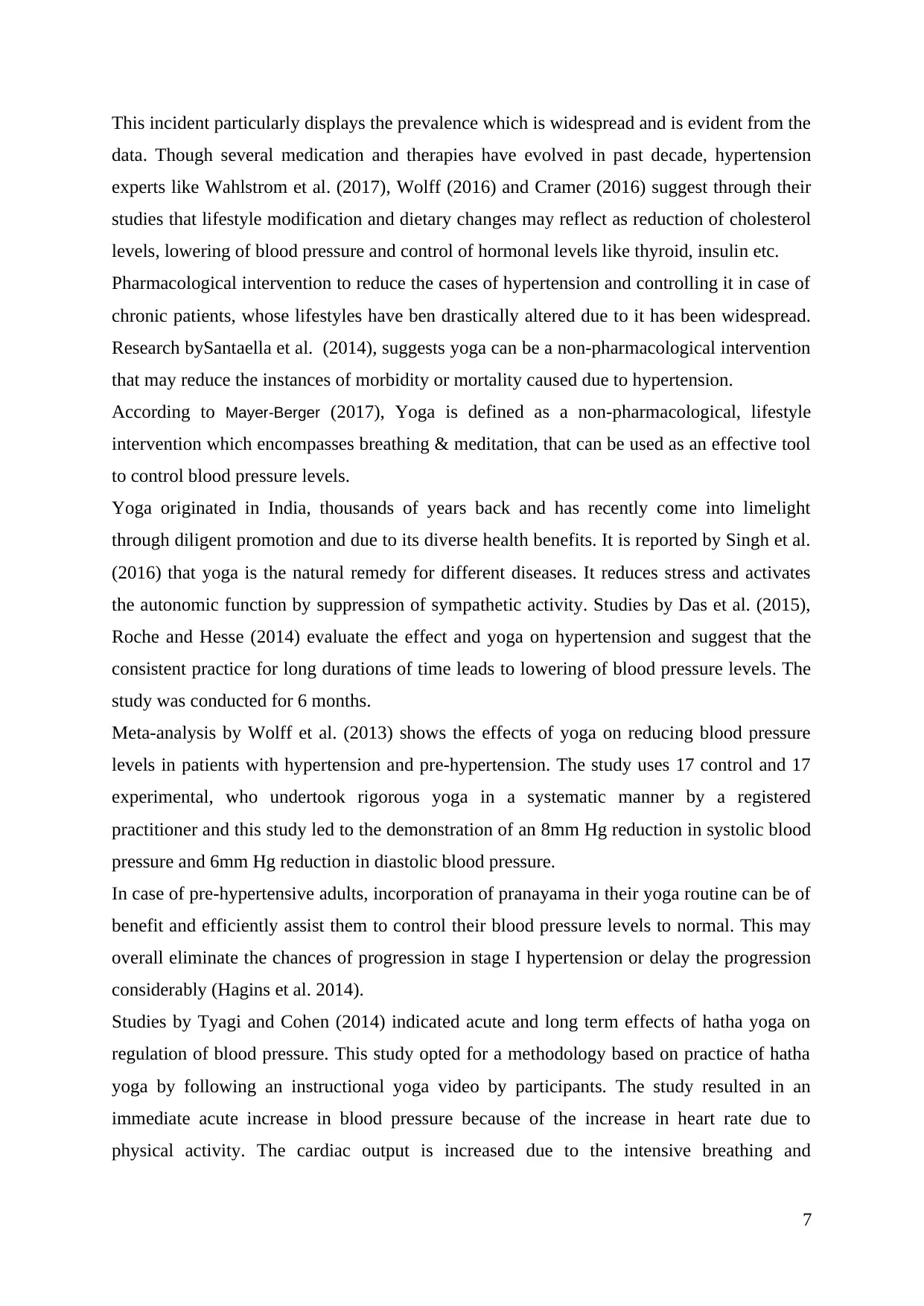
This incident particularly displays the prevalence which is widespread and is evident from the
data. Though several medication and therapies have evolved in past decade, hypertension
experts like Wahlstrom et al. (2017), Wolff (2016) and Cramer (2016) suggest through their
studies that lifestyle modification and dietary changes may reflect as reduction of cholesterol
levels, lowering of blood pressure and control of hormonal levels like thyroid, insulin etc.
Pharmacological intervention to reduce the cases of hypertension and controlling it in case of
chronic patients, whose lifestyles have ben drastically altered due to it has been widespread.
Research bySantaella et al. (2014), suggests yoga can be a non-pharmacological intervention
that may reduce the instances of morbidity or mortality caused due to hypertension.
According to Mayer-Berger (2017), Yoga is defined as a non-pharmacological, lifestyle
intervention which encompasses breathing & meditation, that can be used as an effective tool
to control blood pressure levels.
Yoga originated in India, thousands of years back and has recently come into limelight
through diligent promotion and due to its diverse health benefits. It is reported by Singh et al.
(2016) that yoga is the natural remedy for different diseases. It reduces stress and activates
the autonomic function by suppression of sympathetic activity. Studies by Das et al. (2015),
Roche and Hesse (2014) evaluate the effect and yoga on hypertension and suggest that the
consistent practice for long durations of time leads to lowering of blood pressure levels. The
study was conducted for 6 months.
Meta-analysis by Wolff et al. (2013) shows the effects of yoga on reducing blood pressure
levels in patients with hypertension and pre-hypertension. The study uses 17 control and 17
experimental, who undertook rigorous yoga in a systematic manner by a registered
practitioner and this study led to the demonstration of an 8mm Hg reduction in systolic blood
pressure and 6mm Hg reduction in diastolic blood pressure.
In case of pre-hypertensive adults, incorporation of pranayama in their yoga routine can be of
benefit and efficiently assist them to control their blood pressure levels to normal. This may
overall eliminate the chances of progression in stage I hypertension or delay the progression
considerably (Hagins et al. 2014).
Studies by Tyagi and Cohen (2014) indicated acute and long term effects of hatha yoga on
regulation of blood pressure. This study opted for a methodology based on practice of hatha
yoga by following an instructional yoga video by participants. The study resulted in an
immediate acute increase in blood pressure because of the increase in heart rate due to
physical activity. The cardiac output is increased due to the intensive breathing and
7
data. Though several medication and therapies have evolved in past decade, hypertension
experts like Wahlstrom et al. (2017), Wolff (2016) and Cramer (2016) suggest through their
studies that lifestyle modification and dietary changes may reflect as reduction of cholesterol
levels, lowering of blood pressure and control of hormonal levels like thyroid, insulin etc.
Pharmacological intervention to reduce the cases of hypertension and controlling it in case of
chronic patients, whose lifestyles have ben drastically altered due to it has been widespread.
Research bySantaella et al. (2014), suggests yoga can be a non-pharmacological intervention
that may reduce the instances of morbidity or mortality caused due to hypertension.
According to Mayer-Berger (2017), Yoga is defined as a non-pharmacological, lifestyle
intervention which encompasses breathing & meditation, that can be used as an effective tool
to control blood pressure levels.
Yoga originated in India, thousands of years back and has recently come into limelight
through diligent promotion and due to its diverse health benefits. It is reported by Singh et al.
(2016) that yoga is the natural remedy for different diseases. It reduces stress and activates
the autonomic function by suppression of sympathetic activity. Studies by Das et al. (2015),
Roche and Hesse (2014) evaluate the effect and yoga on hypertension and suggest that the
consistent practice for long durations of time leads to lowering of blood pressure levels. The
study was conducted for 6 months.
Meta-analysis by Wolff et al. (2013) shows the effects of yoga on reducing blood pressure
levels in patients with hypertension and pre-hypertension. The study uses 17 control and 17
experimental, who undertook rigorous yoga in a systematic manner by a registered
practitioner and this study led to the demonstration of an 8mm Hg reduction in systolic blood
pressure and 6mm Hg reduction in diastolic blood pressure.
In case of pre-hypertensive adults, incorporation of pranayama in their yoga routine can be of
benefit and efficiently assist them to control their blood pressure levels to normal. This may
overall eliminate the chances of progression in stage I hypertension or delay the progression
considerably (Hagins et al. 2014).
Studies by Tyagi and Cohen (2014) indicated acute and long term effects of hatha yoga on
regulation of blood pressure. This study opted for a methodology based on practice of hatha
yoga by following an instructional yoga video by participants. The study resulted in an
immediate acute increase in blood pressure because of the increase in heart rate due to
physical activity. The cardiac output is increased due to the intensive breathing and
7
Paraphrase This Document
Need a fresh take? Get an instant paraphrase of this document with our AI Paraphraser
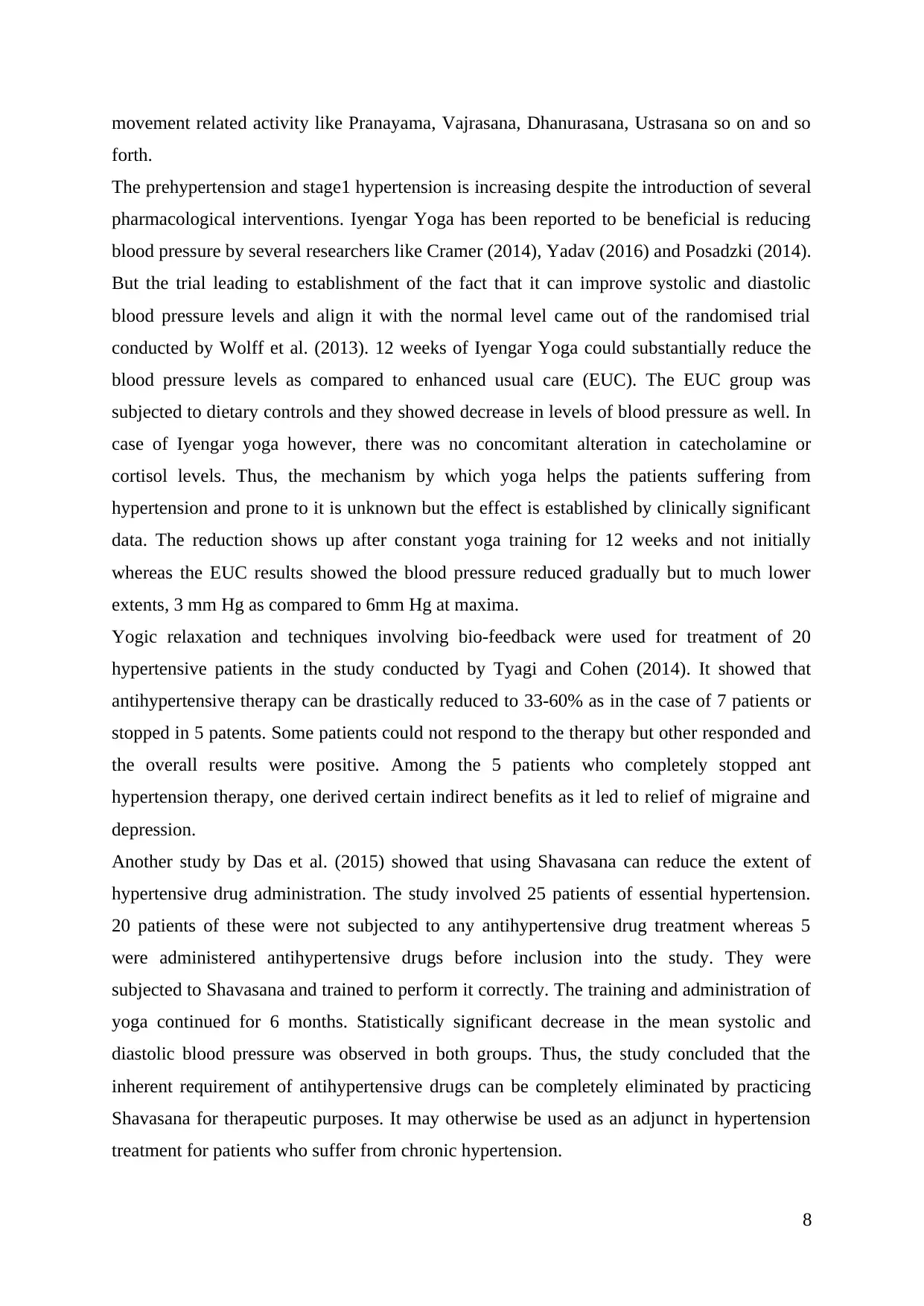
movement related activity like Pranayama, Vajrasana, Dhanurasana, Ustrasana so on and so
forth.
The prehypertension and stage1 hypertension is increasing despite the introduction of several
pharmacological interventions. Iyengar Yoga has been reported to be beneficial is reducing
blood pressure by several researchers like Cramer (2014), Yadav (2016) and Posadzki (2014).
But the trial leading to establishment of the fact that it can improve systolic and diastolic
blood pressure levels and align it with the normal level came out of the randomised trial
conducted by Wolff et al. (2013). 12 weeks of Iyengar Yoga could substantially reduce the
blood pressure levels as compared to enhanced usual care (EUC). The EUC group was
subjected to dietary controls and they showed decrease in levels of blood pressure as well. In
case of Iyengar yoga however, there was no concomitant alteration in catecholamine or
cortisol levels. Thus, the mechanism by which yoga helps the patients suffering from
hypertension and prone to it is unknown but the effect is established by clinically significant
data. The reduction shows up after constant yoga training for 12 weeks and not initially
whereas the EUC results showed the blood pressure reduced gradually but to much lower
extents, 3 mm Hg as compared to 6mm Hg at maxima.
Yogic relaxation and techniques involving bio-feedback were used for treatment of 20
hypertensive patients in the study conducted by Tyagi and Cohen (2014). It showed that
antihypertensive therapy can be drastically reduced to 33-60% as in the case of 7 patients or
stopped in 5 patents. Some patients could not respond to the therapy but other responded and
the overall results were positive. Among the 5 patients who completely stopped ant
hypertension therapy, one derived certain indirect benefits as it led to relief of migraine and
depression.
Another study by Das et al. (2015) showed that using Shavasana can reduce the extent of
hypertensive drug administration. The study involved 25 patients of essential hypertension.
20 patients of these were not subjected to any antihypertensive drug treatment whereas 5
were administered antihypertensive drugs before inclusion into the study. They were
subjected to Shavasana and trained to perform it correctly. The training and administration of
yoga continued for 6 months. Statistically significant decrease in the mean systolic and
diastolic blood pressure was observed in both groups. Thus, the study concluded that the
inherent requirement of antihypertensive drugs can be completely eliminated by practicing
Shavasana for therapeutic purposes. It may otherwise be used as an adjunct in hypertension
treatment for patients who suffer from chronic hypertension.
8
forth.
The prehypertension and stage1 hypertension is increasing despite the introduction of several
pharmacological interventions. Iyengar Yoga has been reported to be beneficial is reducing
blood pressure by several researchers like Cramer (2014), Yadav (2016) and Posadzki (2014).
But the trial leading to establishment of the fact that it can improve systolic and diastolic
blood pressure levels and align it with the normal level came out of the randomised trial
conducted by Wolff et al. (2013). 12 weeks of Iyengar Yoga could substantially reduce the
blood pressure levels as compared to enhanced usual care (EUC). The EUC group was
subjected to dietary controls and they showed decrease in levels of blood pressure as well. In
case of Iyengar yoga however, there was no concomitant alteration in catecholamine or
cortisol levels. Thus, the mechanism by which yoga helps the patients suffering from
hypertension and prone to it is unknown but the effect is established by clinically significant
data. The reduction shows up after constant yoga training for 12 weeks and not initially
whereas the EUC results showed the blood pressure reduced gradually but to much lower
extents, 3 mm Hg as compared to 6mm Hg at maxima.
Yogic relaxation and techniques involving bio-feedback were used for treatment of 20
hypertensive patients in the study conducted by Tyagi and Cohen (2014). It showed that
antihypertensive therapy can be drastically reduced to 33-60% as in the case of 7 patients or
stopped in 5 patents. Some patients could not respond to the therapy but other responded and
the overall results were positive. Among the 5 patients who completely stopped ant
hypertension therapy, one derived certain indirect benefits as it led to relief of migraine and
depression.
Another study by Das et al. (2015) showed that using Shavasana can reduce the extent of
hypertensive drug administration. The study involved 25 patients of essential hypertension.
20 patients of these were not subjected to any antihypertensive drug treatment whereas 5
were administered antihypertensive drugs before inclusion into the study. They were
subjected to Shavasana and trained to perform it correctly. The training and administration of
yoga continued for 6 months. Statistically significant decrease in the mean systolic and
diastolic blood pressure was observed in both groups. Thus, the study concluded that the
inherent requirement of antihypertensive drugs can be completely eliminated by practicing
Shavasana for therapeutic purposes. It may otherwise be used as an adjunct in hypertension
treatment for patients who suffer from chronic hypertension.
8
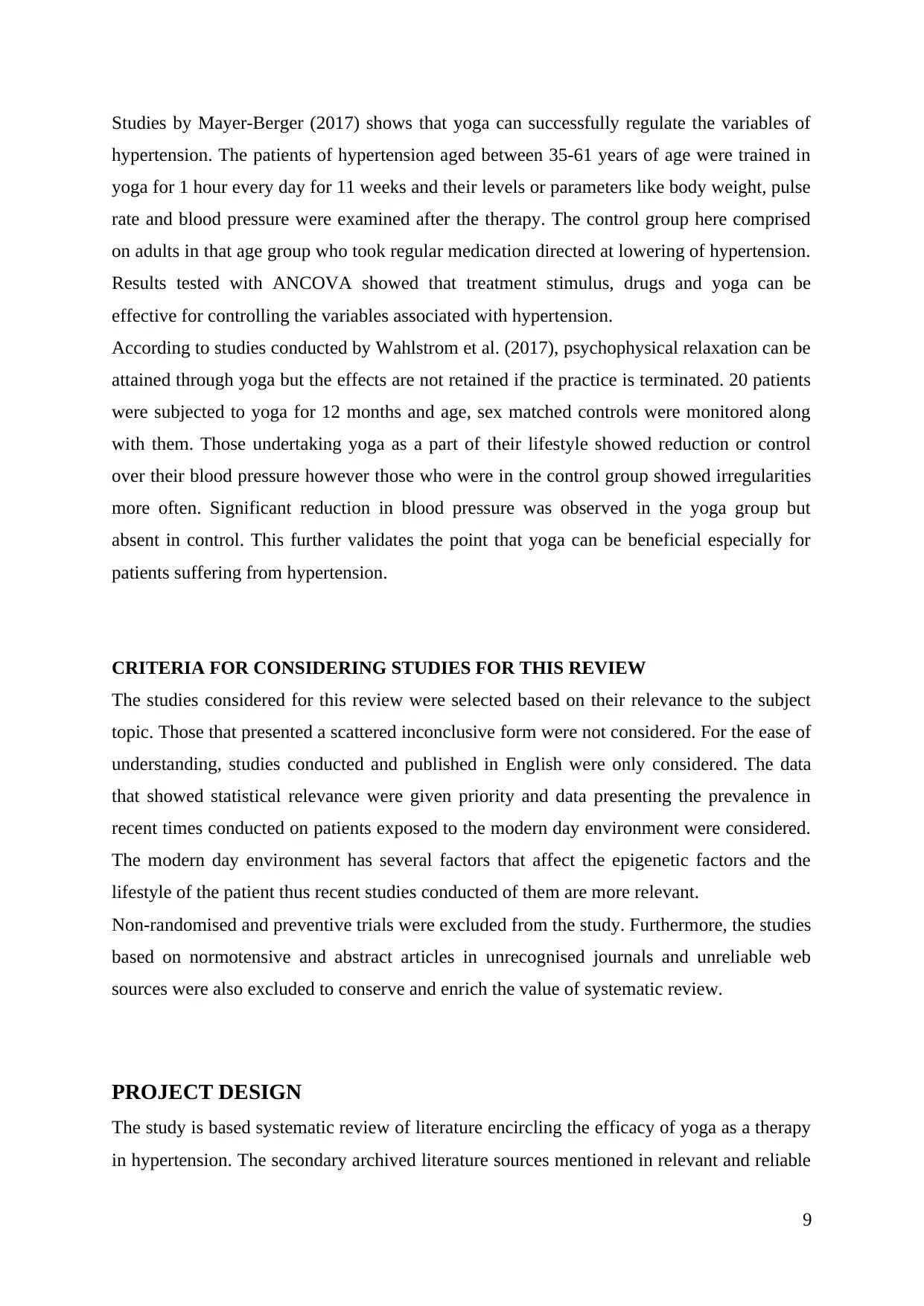
Studies by Mayer-Berger (2017) shows that yoga can successfully regulate the variables of
hypertension. The patients of hypertension aged between 35-61 years of age were trained in
yoga for 1 hour every day for 11 weeks and their levels or parameters like body weight, pulse
rate and blood pressure were examined after the therapy. The control group here comprised
on adults in that age group who took regular medication directed at lowering of hypertension.
Results tested with ANCOVA showed that treatment stimulus, drugs and yoga can be
effective for controlling the variables associated with hypertension.
According to studies conducted by Wahlstrom et al. (2017), psychophysical relaxation can be
attained through yoga but the effects are not retained if the practice is terminated. 20 patients
were subjected to yoga for 12 months and age, sex matched controls were monitored along
with them. Those undertaking yoga as a part of their lifestyle showed reduction or control
over their blood pressure however those who were in the control group showed irregularities
more often. Significant reduction in blood pressure was observed in the yoga group but
absent in control. This further validates the point that yoga can be beneficial especially for
patients suffering from hypertension.
CRITERIA FOR CONSIDERING STUDIES FOR THIS REVIEW
The studies considered for this review were selected based on their relevance to the subject
topic. Those that presented a scattered inconclusive form were not considered. For the ease of
understanding, studies conducted and published in English were only considered. The data
that showed statistical relevance were given priority and data presenting the prevalence in
recent times conducted on patients exposed to the modern day environment were considered.
The modern day environment has several factors that affect the epigenetic factors and the
lifestyle of the patient thus recent studies conducted of them are more relevant.
Non-randomised and preventive trials were excluded from the study. Furthermore, the studies
based on normotensive and abstract articles in unrecognised journals and unreliable web
sources were also excluded to conserve and enrich the value of systematic review.
PROJECT DESIGN
The study is based systematic review of literature encircling the efficacy of yoga as a therapy
in hypertension. The secondary archived literature sources mentioned in relevant and reliable
9
hypertension. The patients of hypertension aged between 35-61 years of age were trained in
yoga for 1 hour every day for 11 weeks and their levels or parameters like body weight, pulse
rate and blood pressure were examined after the therapy. The control group here comprised
on adults in that age group who took regular medication directed at lowering of hypertension.
Results tested with ANCOVA showed that treatment stimulus, drugs and yoga can be
effective for controlling the variables associated with hypertension.
According to studies conducted by Wahlstrom et al. (2017), psychophysical relaxation can be
attained through yoga but the effects are not retained if the practice is terminated. 20 patients
were subjected to yoga for 12 months and age, sex matched controls were monitored along
with them. Those undertaking yoga as a part of their lifestyle showed reduction or control
over their blood pressure however those who were in the control group showed irregularities
more often. Significant reduction in blood pressure was observed in the yoga group but
absent in control. This further validates the point that yoga can be beneficial especially for
patients suffering from hypertension.
CRITERIA FOR CONSIDERING STUDIES FOR THIS REVIEW
The studies considered for this review were selected based on their relevance to the subject
topic. Those that presented a scattered inconclusive form were not considered. For the ease of
understanding, studies conducted and published in English were only considered. The data
that showed statistical relevance were given priority and data presenting the prevalence in
recent times conducted on patients exposed to the modern day environment were considered.
The modern day environment has several factors that affect the epigenetic factors and the
lifestyle of the patient thus recent studies conducted of them are more relevant.
Non-randomised and preventive trials were excluded from the study. Furthermore, the studies
based on normotensive and abstract articles in unrecognised journals and unreliable web
sources were also excluded to conserve and enrich the value of systematic review.
PROJECT DESIGN
The study is based systematic review of literature encircling the efficacy of yoga as a therapy
in hypertension. The secondary archived literature sources mentioned in relevant and reliable
9
⊘ This is a preview!⊘
Do you want full access?
Subscribe today to unlock all pages.

Trusted by 1+ million students worldwide
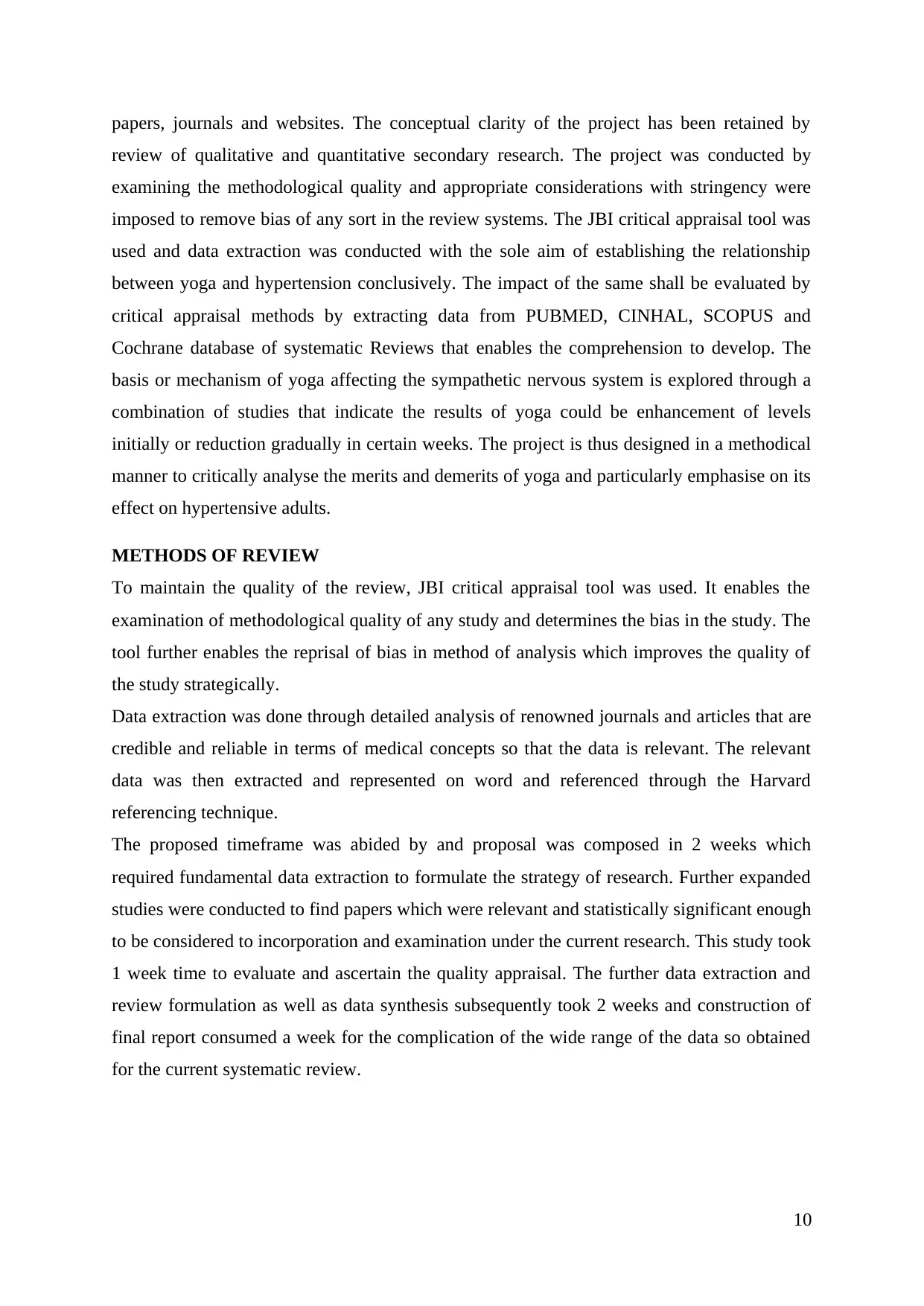
papers, journals and websites. The conceptual clarity of the project has been retained by
review of qualitative and quantitative secondary research. The project was conducted by
examining the methodological quality and appropriate considerations with stringency were
imposed to remove bias of any sort in the review systems. The JBI critical appraisal tool was
used and data extraction was conducted with the sole aim of establishing the relationship
between yoga and hypertension conclusively. The impact of the same shall be evaluated by
critical appraisal methods by extracting data from PUBMED, CINHAL, SCOPUS and
Cochrane database of systematic Reviews that enables the comprehension to develop. The
basis or mechanism of yoga affecting the sympathetic nervous system is explored through a
combination of studies that indicate the results of yoga could be enhancement of levels
initially or reduction gradually in certain weeks. The project is thus designed in a methodical
manner to critically analyse the merits and demerits of yoga and particularly emphasise on its
effect on hypertensive adults.
METHODS OF REVIEW
To maintain the quality of the review, JBI critical appraisal tool was used. It enables the
examination of methodological quality of any study and determines the bias in the study. The
tool further enables the reprisal of bias in method of analysis which improves the quality of
the study strategically.
Data extraction was done through detailed analysis of renowned journals and articles that are
credible and reliable in terms of medical concepts so that the data is relevant. The relevant
data was then extracted and represented on word and referenced through the Harvard
referencing technique.
The proposed timeframe was abided by and proposal was composed in 2 weeks which
required fundamental data extraction to formulate the strategy of research. Further expanded
studies were conducted to find papers which were relevant and statistically significant enough
to be considered to incorporation and examination under the current research. This study took
1 week time to evaluate and ascertain the quality appraisal. The further data extraction and
review formulation as well as data synthesis subsequently took 2 weeks and construction of
final report consumed a week for the complication of the wide range of the data so obtained
for the current systematic review.
10
review of qualitative and quantitative secondary research. The project was conducted by
examining the methodological quality and appropriate considerations with stringency were
imposed to remove bias of any sort in the review systems. The JBI critical appraisal tool was
used and data extraction was conducted with the sole aim of establishing the relationship
between yoga and hypertension conclusively. The impact of the same shall be evaluated by
critical appraisal methods by extracting data from PUBMED, CINHAL, SCOPUS and
Cochrane database of systematic Reviews that enables the comprehension to develop. The
basis or mechanism of yoga affecting the sympathetic nervous system is explored through a
combination of studies that indicate the results of yoga could be enhancement of levels
initially or reduction gradually in certain weeks. The project is thus designed in a methodical
manner to critically analyse the merits and demerits of yoga and particularly emphasise on its
effect on hypertensive adults.
METHODS OF REVIEW
To maintain the quality of the review, JBI critical appraisal tool was used. It enables the
examination of methodological quality of any study and determines the bias in the study. The
tool further enables the reprisal of bias in method of analysis which improves the quality of
the study strategically.
Data extraction was done through detailed analysis of renowned journals and articles that are
credible and reliable in terms of medical concepts so that the data is relevant. The relevant
data was then extracted and represented on word and referenced through the Harvard
referencing technique.
The proposed timeframe was abided by and proposal was composed in 2 weeks which
required fundamental data extraction to formulate the strategy of research. Further expanded
studies were conducted to find papers which were relevant and statistically significant enough
to be considered to incorporation and examination under the current research. This study took
1 week time to evaluate and ascertain the quality appraisal. The further data extraction and
review formulation as well as data synthesis subsequently took 2 weeks and construction of
final report consumed a week for the complication of the wide range of the data so obtained
for the current systematic review.
10
Paraphrase This Document
Need a fresh take? Get an instant paraphrase of this document with our AI Paraphraser
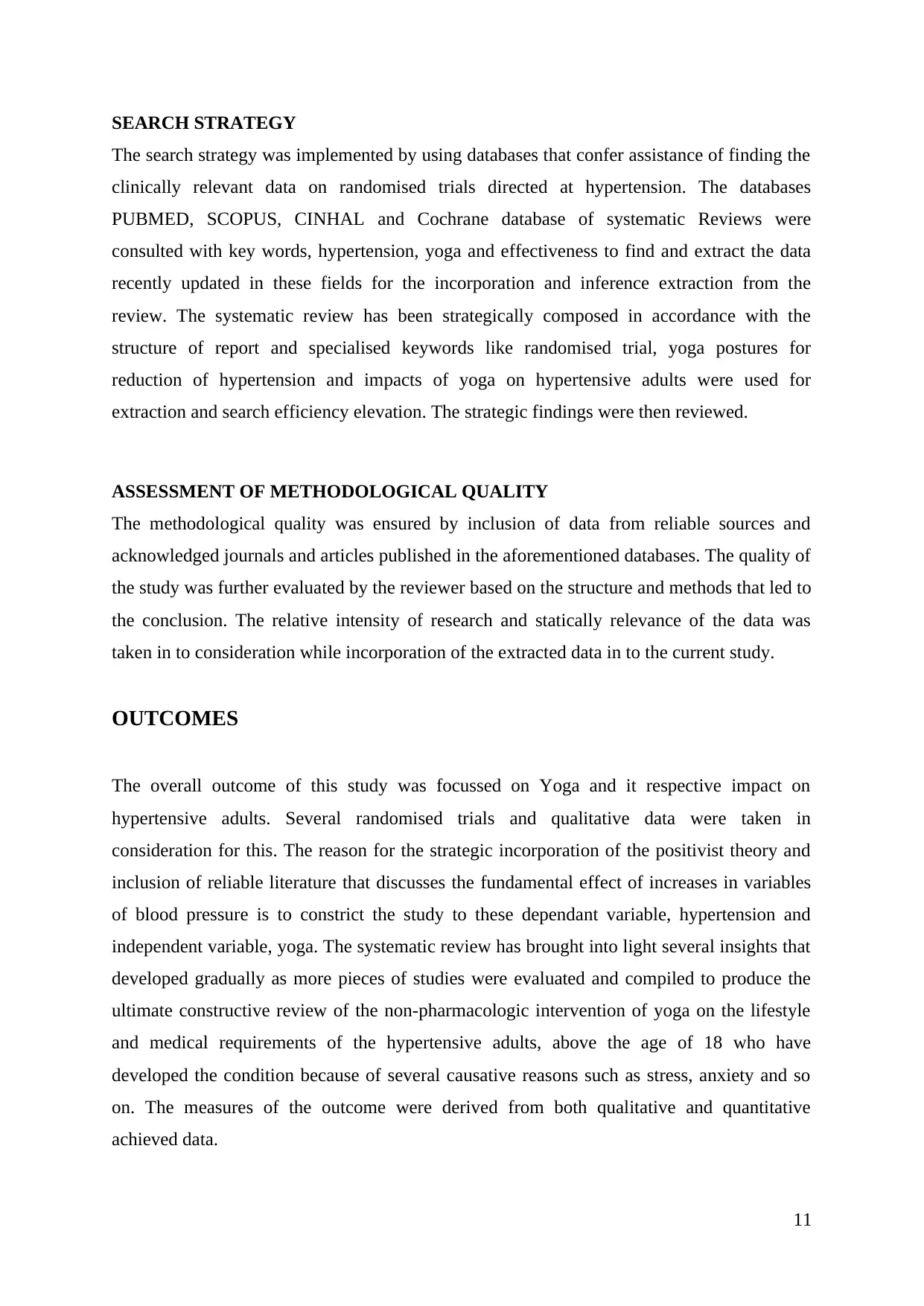
SEARCH STRATEGY
The search strategy was implemented by using databases that confer assistance of finding the
clinically relevant data on randomised trials directed at hypertension. The databases
PUBMED, SCOPUS, CINHAL and Cochrane database of systematic Reviews were
consulted with key words, hypertension, yoga and effectiveness to find and extract the data
recently updated in these fields for the incorporation and inference extraction from the
review. The systematic review has been strategically composed in accordance with the
structure of report and specialised keywords like randomised trial, yoga postures for
reduction of hypertension and impacts of yoga on hypertensive adults were used for
extraction and search efficiency elevation. The strategic findings were then reviewed.
ASSESSMENT OF METHODOLOGICAL QUALITY
The methodological quality was ensured by inclusion of data from reliable sources and
acknowledged journals and articles published in the aforementioned databases. The quality of
the study was further evaluated by the reviewer based on the structure and methods that led to
the conclusion. The relative intensity of research and statically relevance of the data was
taken in to consideration while incorporation of the extracted data in to the current study.
OUTCOMES
The overall outcome of this study was focussed on Yoga and it respective impact on
hypertensive adults. Several randomised trials and qualitative data were taken in
consideration for this. The reason for the strategic incorporation of the positivist theory and
inclusion of reliable literature that discusses the fundamental effect of increases in variables
of blood pressure is to constrict the study to these dependant variable, hypertension and
independent variable, yoga. The systematic review has brought into light several insights that
developed gradually as more pieces of studies were evaluated and compiled to produce the
ultimate constructive review of the non-pharmacologic intervention of yoga on the lifestyle
and medical requirements of the hypertensive adults, above the age of 18 who have
developed the condition because of several causative reasons such as stress, anxiety and so
on. The measures of the outcome were derived from both qualitative and quantitative
achieved data.
11
The search strategy was implemented by using databases that confer assistance of finding the
clinically relevant data on randomised trials directed at hypertension. The databases
PUBMED, SCOPUS, CINHAL and Cochrane database of systematic Reviews were
consulted with key words, hypertension, yoga and effectiveness to find and extract the data
recently updated in these fields for the incorporation and inference extraction from the
review. The systematic review has been strategically composed in accordance with the
structure of report and specialised keywords like randomised trial, yoga postures for
reduction of hypertension and impacts of yoga on hypertensive adults were used for
extraction and search efficiency elevation. The strategic findings were then reviewed.
ASSESSMENT OF METHODOLOGICAL QUALITY
The methodological quality was ensured by inclusion of data from reliable sources and
acknowledged journals and articles published in the aforementioned databases. The quality of
the study was further evaluated by the reviewer based on the structure and methods that led to
the conclusion. The relative intensity of research and statically relevance of the data was
taken in to consideration while incorporation of the extracted data in to the current study.
OUTCOMES
The overall outcome of this study was focussed on Yoga and it respective impact on
hypertensive adults. Several randomised trials and qualitative data were taken in
consideration for this. The reason for the strategic incorporation of the positivist theory and
inclusion of reliable literature that discusses the fundamental effect of increases in variables
of blood pressure is to constrict the study to these dependant variable, hypertension and
independent variable, yoga. The systematic review has brought into light several insights that
developed gradually as more pieces of studies were evaluated and compiled to produce the
ultimate constructive review of the non-pharmacologic intervention of yoga on the lifestyle
and medical requirements of the hypertensive adults, above the age of 18 who have
developed the condition because of several causative reasons such as stress, anxiety and so
on. The measures of the outcome were derived from both qualitative and quantitative
achieved data.
11
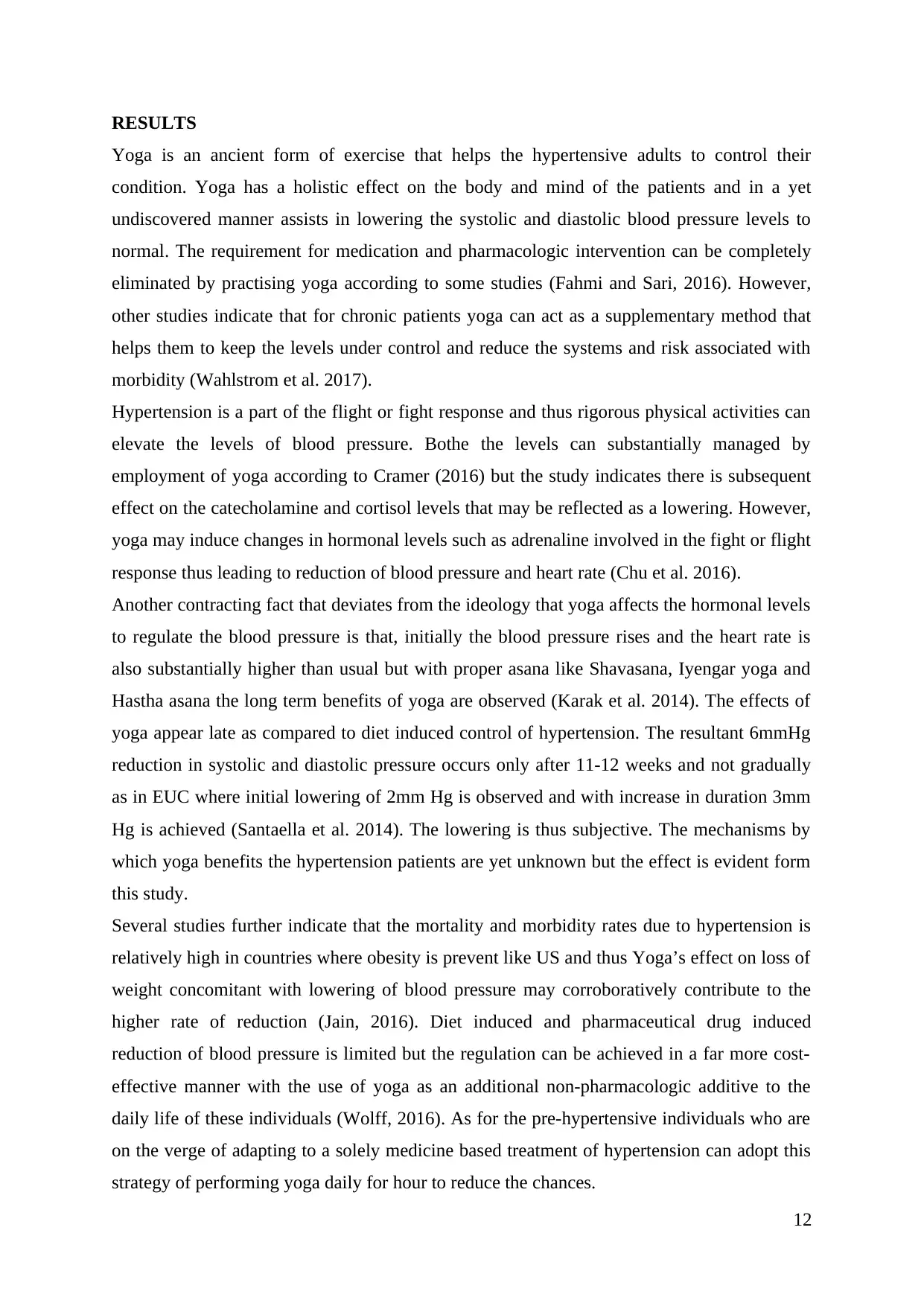
RESULTS
Yoga is an ancient form of exercise that helps the hypertensive adults to control their
condition. Yoga has a holistic effect on the body and mind of the patients and in a yet
undiscovered manner assists in lowering the systolic and diastolic blood pressure levels to
normal. The requirement for medication and pharmacologic intervention can be completely
eliminated by practising yoga according to some studies (Fahmi and Sari, 2016). However,
other studies indicate that for chronic patients yoga can act as a supplementary method that
helps them to keep the levels under control and reduce the systems and risk associated with
morbidity (Wahlstrom et al. 2017).
Hypertension is a part of the flight or fight response and thus rigorous physical activities can
elevate the levels of blood pressure. Bothe the levels can substantially managed by
employment of yoga according to Cramer (2016) but the study indicates there is subsequent
effect on the catecholamine and cortisol levels that may be reflected as a lowering. However,
yoga may induce changes in hormonal levels such as adrenaline involved in the fight or flight
response thus leading to reduction of blood pressure and heart rate (Chu et al. 2016).
Another contracting fact that deviates from the ideology that yoga affects the hormonal levels
to regulate the blood pressure is that, initially the blood pressure rises and the heart rate is
also substantially higher than usual but with proper asana like Shavasana, Iyengar yoga and
Hastha asana the long term benefits of yoga are observed (Karak et al. 2014). The effects of
yoga appear late as compared to diet induced control of hypertension. The resultant 6mmHg
reduction in systolic and diastolic pressure occurs only after 11-12 weeks and not gradually
as in EUC where initial lowering of 2mm Hg is observed and with increase in duration 3mm
Hg is achieved (Santaella et al. 2014). The lowering is thus subjective. The mechanisms by
which yoga benefits the hypertension patients are yet unknown but the effect is evident form
this study.
Several studies further indicate that the mortality and morbidity rates due to hypertension is
relatively high in countries where obesity is prevent like US and thus Yoga’s effect on loss of
weight concomitant with lowering of blood pressure may corroboratively contribute to the
higher rate of reduction (Jain, 2016). Diet induced and pharmaceutical drug induced
reduction of blood pressure is limited but the regulation can be achieved in a far more cost-
effective manner with the use of yoga as an additional non-pharmacologic additive to the
daily life of these individuals (Wolff, 2016). As for the pre-hypertensive individuals who are
on the verge of adapting to a solely medicine based treatment of hypertension can adopt this
strategy of performing yoga daily for hour to reduce the chances.
12
Yoga is an ancient form of exercise that helps the hypertensive adults to control their
condition. Yoga has a holistic effect on the body and mind of the patients and in a yet
undiscovered manner assists in lowering the systolic and diastolic blood pressure levels to
normal. The requirement for medication and pharmacologic intervention can be completely
eliminated by practising yoga according to some studies (Fahmi and Sari, 2016). However,
other studies indicate that for chronic patients yoga can act as a supplementary method that
helps them to keep the levels under control and reduce the systems and risk associated with
morbidity (Wahlstrom et al. 2017).
Hypertension is a part of the flight or fight response and thus rigorous physical activities can
elevate the levels of blood pressure. Bothe the levels can substantially managed by
employment of yoga according to Cramer (2016) but the study indicates there is subsequent
effect on the catecholamine and cortisol levels that may be reflected as a lowering. However,
yoga may induce changes in hormonal levels such as adrenaline involved in the fight or flight
response thus leading to reduction of blood pressure and heart rate (Chu et al. 2016).
Another contracting fact that deviates from the ideology that yoga affects the hormonal levels
to regulate the blood pressure is that, initially the blood pressure rises and the heart rate is
also substantially higher than usual but with proper asana like Shavasana, Iyengar yoga and
Hastha asana the long term benefits of yoga are observed (Karak et al. 2014). The effects of
yoga appear late as compared to diet induced control of hypertension. The resultant 6mmHg
reduction in systolic and diastolic pressure occurs only after 11-12 weeks and not gradually
as in EUC where initial lowering of 2mm Hg is observed and with increase in duration 3mm
Hg is achieved (Santaella et al. 2014). The lowering is thus subjective. The mechanisms by
which yoga benefits the hypertension patients are yet unknown but the effect is evident form
this study.
Several studies further indicate that the mortality and morbidity rates due to hypertension is
relatively high in countries where obesity is prevent like US and thus Yoga’s effect on loss of
weight concomitant with lowering of blood pressure may corroboratively contribute to the
higher rate of reduction (Jain, 2016). Diet induced and pharmaceutical drug induced
reduction of blood pressure is limited but the regulation can be achieved in a far more cost-
effective manner with the use of yoga as an additional non-pharmacologic additive to the
daily life of these individuals (Wolff, 2016). As for the pre-hypertensive individuals who are
on the verge of adapting to a solely medicine based treatment of hypertension can adopt this
strategy of performing yoga daily for hour to reduce the chances.
12
⊘ This is a preview!⊘
Do you want full access?
Subscribe today to unlock all pages.

Trusted by 1+ million students worldwide
1 out of 18
Related Documents
Your All-in-One AI-Powered Toolkit for Academic Success.
+13062052269
info@desklib.com
Available 24*7 on WhatsApp / Email
![[object Object]](/_next/static/media/star-bottom.7253800d.svg)
Unlock your academic potential
Copyright © 2020–2025 A2Z Services. All Rights Reserved. Developed and managed by ZUCOL.





